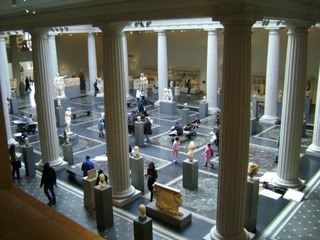Managed to check out the exhibition a couple of weeks ago. The Metropolitan Museum allocated some relatively spacious rooms for the exhibit and even though there were quite a number of visitors it didn't feel crowded at all.
I am familiar with the gold from Tillya Tepe having seen many photographs over the years, but some things still surprised me. The winged Aphrodite is unexpectedly small and the detail on even smaller items is incredible; this in contrast to a bangle and ankle bracelet which are completely undecorated, thick, round, and huge! They seem so incongruous and must have been quite painful to wear, I think.
The items from Begram area are a study in contrast, being mostly from the 1st century AD. Some demonstrate Greek influence on Indian art while others are recognizably Greek. Especially delightful are the large decorated glass fish in which (it is believed) were kept perfumes. Some other glass pieces actually shocked me - painted glass goblets which look almost like ancient versions of the plastic tumblers given out by McDonalds or Burger King!
There are a couple of possible "Alexanders" also: one a bronze "young horse rider" with fairly long hair and an anastole, very similar to other bronzes thought to be Alexander. Interestingly, the catalogue description does not mention Alexander, but the card at the exhibit makes the comparison. Then there's another piece where neither the museum or the catalogue makes any reference to Alexander - a scale weight which "originally may have functioned as a cosmetic jar" and is described as "depicting the bust of a helmeted individual wearing a cuirass, perhaps the god Mars". Well ... the hair under the helmet falls in long curls and has an anastole; the eyes (which once held jewels) are looking upwards; the nose and lips are familiar from other representations of Alexander, and the head is tilted to one side! My first thought on catching sight of this bust was, "Alexander!" and I was quite surprised to see it referred to only as "perhaps" the god Mars. Just goes to show how reticent most archaeologists and museum curators are about suggesting that a find might be an Alexander (quite in contrast to the little piece found recently in Egypt).
There wasn't much at all from Ai Khanum and it's extremely unlikely that anything will be found there in the future. A short film is on display in an attached room at the exhibit and includes a photograph of the site taken in 2004 (it can also be seen in the catalogue). The photograph was taken looking towards the river and in the background can be seen what little remains of the original excavations. Even the excavated short walls appear to have been destroyed and only a few foundation platforms are visible. Worse though is the foreground, from the excavation remains right up to where the cameraman stands. It looks for all the world like a close-up of the moon with thousands and thousands of small craters, or the beach at the beginning of a rainstorm when the first drops form holes in the sand. From an archaeological perspective this has to be one of the saddest photographs I have ever seen.

We weren't allowed to take photographs and this has been the norm at other museums where the exhibit has been shown, but the catalogue more than makes up for it. There's one currently available on Amazon -
Afghanistan: Hidden Treasures from the National Museum, Kabul - but when I looked a couple of weeks ago there were others so if you're interested you could keep checking the site. Alternatively, go to Addall.com and type the title in the Used Books field. There are quite a number there, including bookstores in other parts of the world and not just the U.S. Personally, I wholeheartedly recommend this book - think it is absolutely beautiful and invaluable for those with an interest in Alexander in the east and the Greek influence after his conquest.
One last minor item of interest … well, to me anyway. The voiceover on the museum film pronounced
Ai Khanum as
Ai Hanum, with the "H" being a guttural sound as if the letter is being swallowed and then spit back out again. (Yes, I’m sure there is a word exactly describing this sound, but I wouldn't know how to begin Googling for it!

) At the time I laughed and thought "I've been saying it wrong for years," ... and then the announcer pronounced gymnasium with a hard "g" and completely threw me off! Now, this is a National Geographic production and I doubt that such an error would slip by them, so I'm wondering if they intentionally used pronunciation in the language of origin. Which leads me to ask. Is gymnasium in Greek pronounced with a hard "g"?
Best regards,
